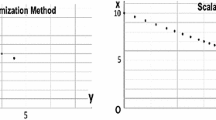Abstract
The continuous network design problem (CNDP) is characterized by a bilevel programming model, in which the upper level problem is generally to minimize the total system cost under limited expenditure, while at the lower level the network users make choices with regard to route conditions following the user equilibrium principle. In this paper, the bilevel programming model for CNDP is transformed into a single level convex programming problem by virtue of an optimal-value function tool and the relationship between System Optimum (SO) and User Equilibrium (UE). By exploring the inherent nature of the CNDP, the optimal-value function for the lower level user equilibrium problem is proved to be continuously differentiable and its derivative in link capacity enhancement can be obtained efficiently by implementing user equilibrium assignment subroutine. However, the reaction (or response) function between the upper and lower level problem is implicit and its gradient is difficult to obtain. Although, here we approximately express the gradient with the difference concept at each iteration, based on the method of successive averages (MSA), we propose a globally convergent algorithm to solve the single level convex programming problem. Comparing with widely used heuristic algorithms, such as sensitivity analysis based (SAB) method, the proposed algorithm needs not strong hypothesis conditions and complex computation for the inverse matrix. Finally, a numerical example is presented to compare the proposed method with some existing algorithms.
Similar content being viewed by others
References
Abdulaal M, LeBlanc LJ (1979) Continuous equilibrium network design models. Transp Res B 13:19–32
Boyce DE (1984) Urban transportation network equilibrium and design models: recent achievements and future prospectives. Environ Plan A 16:1445–1474
Chiou SW (1999) Optimization of area traffic control for equilibrium network flows. Transp Sci 33:279–289
Cho HJ (1988) Sensitivity analysis of equilibrium network flows and its application to the development of solution methods for equilibrium network design problems. PhD dissertation. University of Pennsylvania, Philadelphia
Cree ND, Maher MJ (1998) The continuous equilibrium optimal network design problem: a genetic approach. In: Transportation networks: recent methodological advances. Elsevier, Netherlands, pp 163–174
Dafermos S (1980) Traffic equilibria and variational inequalities. Transp Sci 14:42–54
Dafermos S, Nagurney A (1984) Sensitivity analysis for the asymmetric network equilibrium problem. Math Program 28:174–184
Friesz TL (1981) An equivalent optimization problem with combined multiclass distribution assignment and modal split which obviates symmetry restriction. Transp Res B 15:361–369
Friesz TL (1985) Transportation network equilibrium, design and aggregation: key developments and research opportunities. Transp Res A 19:413–427
Friesz TL, Harker PT (1985) Properties of the iterative optimization equilibrium algorithm. Civ Eng Syst 2:142–154
Friesz TL et al (1990) Sensitivity analysis based heuristic algorithms for mathematical programs with variational inequality constraints. Math Program 48:265–284
Friesz TL et al (1993) The multiobjective equilibrium network design problem revisited: a simulated annealing approach. Eur J Oper Res 65:44–57
Gao ZY, Song YF (2002) A reserve capacity model of optimal signal control with user-equilibrium route choice. Transp Res B 36:313–323
Gao ZY, Song YF Si BF (2000) Urban transportation continuous equilibrium network design problem: theory and method. China Railway Press, Beijing
Gao ZY, Wu JJ, Sun HJ (2005) Solution algorithm for the bi-level discrete network design problem. Transport Res B 39:479–495
Kim TJ (1990) Advanced transport and spatial systems models: applications to Korea. Springer, New York
Kim TJ, Suh S (1988) Toward developing a national transportation planning model: a bilevel programming approach for Korea. Ann Reg Sci XXSPED:65–80
Luo ZQ, Pang JS, Ralph D (1996) Mathematical programs with equilibrium constraints. Cambridge University Press, Cambridge
Magnanti TL, Wong RT (1984) Network design and transportation planning: models and algorithms. Transp Sci 18:1–55
Mangasarian OL, Rosen JB (1964) Inequalities for stochastic nonlinear programming problems. Oper Res 12:143–154
Marcotte P (1983) Network optimization with continuous control parameters. Transp Sci 17:181–197
Marcotte P (1986) Network design problem with congestion effects: a case of bi-level programming. Math Program 34:142–162
Marcotte P, Marquis G (1992) Efficient implementation of heuristics for the continuous network design problem. Ann Oper Res 34:163–176
Marcotte P, Zhu DL (1996) Exact and inexact penalty methods for the generalized bilevel programming problems. Math Program 74:141–157
Meng Q, Yang H, Bell MGH (2001) An equivalent continuously differentiable model and a locally convergent algorithm for the continuous networks design problem. Transp Res B 35:83–105
Patriksson M (1994) The traffic assignment problem models and methods. VSB BV, Netherlands
Powell WB, Sheffi Y (1982) The convergence of equilibrium algorithms with predetermined step size. Transp Sci 6:5–55
Rockafellar RT (1970) Convex analysis. Princeton University Press, Princeton
Sheffi Y (1985) Urban transportation networks: equilibrium analysis with mathematical programming methods. Prentice–Hall, Englewood Cliffs
Shimizu K, Ishizuka Y, Bard JF (1997) Nondifferentiable and two-level mathematical programming. Kluwer Academic, Massachusetts
Suwansirikul C, Friesz TL, Tobin RL (1987) Equilibrium decomposed optimization: a heuristic for the continuous equilibrium network design problem. Transp Sci 21:254–263
Tan HN, Gershwin SB, Athans M (1979) Hybrid optimization in urban traffic networks. Report No. DOT-TSC-RSPA-79-7. Laboratory for Information and Decision System, MIT, Cambridge, MA
Tobin RL, Friesz TL (1988) Sensitivity analysis for equilibrium network flows. Transp Sci 22:242–250
Wong SC, Yang H (1997) Reserve capacity of a signal-controlled road network. Transp Res Part B 31:397–402
Yang H (1995) Sensitivity analysis for queuing equilibrium network flow and its application to traffic control. Math Comput Model 22:247–258
Yang H (1997) Sensitivity analysis for the elastic demand network equilibrium problem with applications. Transp Res B 31:55–70
Yang H, Bell MGH (1998) Models and algorithm for road network design: a review and some new developments. Transp Rev 18(3):257–278
Yang H, Yagar S (1994) Traffic assignment and traffic control in general freeway-arterial corridor systems. Transp Res B 28:463–486
Yang H, Meng Q, Liu GS (2004) The generalized transportation network optimization problem: models and algorithms. Working Paper, The Hong Kong University of Science and Technology
Author information
Authors and Affiliations
Corresponding author
Rights and permissions
About this article
Cite this article
Gao, Z., Sun, H. & Zhang, H. A globally convergent algorithm for transportation continuous network design problem. Optim Eng 8, 241–257 (2007). https://doi.org/10.1007/s11081-007-9015-1
Published:
Issue Date:
DOI: https://doi.org/10.1007/s11081-007-9015-1




